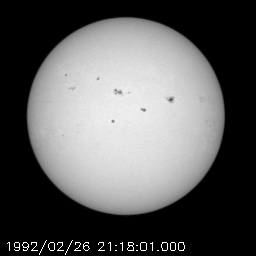Part I
Overview
In this activity, you will work as a team of NASA scientists to make
repeated observations of our Sun and the planets to determine rotation
rates.
ROTATION is the length of time for an object to spin once on its axis. Planetary rotation rates are measured by using telescopes or space probes. Scientists carefully pick a particular feature on the planet (a large crater, a mountain, a spot, etc). The task is then to determine how long the feature takes to move from one side of the planetary disk to the other side; this would be one-half of the rotation rate.
![]()
Part I
View this movie showing the rotating Earth. It was made in 1994 but people have known that Earth rotates once on its axis in 24 hrs for thousands of years.
Your first task it to develop and write out a strategy that you could
use determine the rotational period of a distant planet.
![]()
Part II
View solar image number 001. Notice the location of these spots on the solar surface. Now look at solar image number 002. Where are the spots now? You should note that on the bottom of each image is a time and date mark. These will be very helpful in determining the rotation rate for our Sun. Solar image number 003 appears on a page with lots of additional solar images.
Determine the rotation rate of our Sun by watching sunspots move from one side to the other. This is how Galileo determined the solar rotation rate in 1610. An animated image of solar rotation is available too!
 |
 |
|
|
|
Working as NASA science teams, you will be assigned one of the following solar system objects. Your team should create a multi-media report that includes six parts: